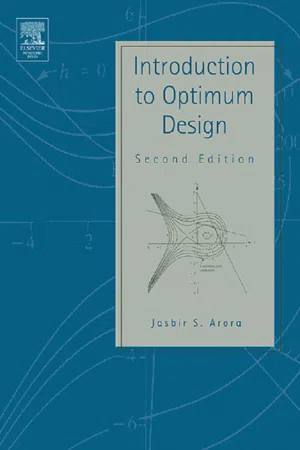![]()
1 Introduction to Design
Upon completion of this chapter, you will be able to:
• Describe the overall process of designing systems
• Distinguish between engineering design and engineering analysis activity
• Distinguish between the conventional design process and optimum design process
• Distinguish between the optimum design and optimal control problems
• Understand the notations used for operations with vectors, matrices, and functions
Engineering consists of a number of well established activities, including analysis, design, fabrication, sales, research, and the development of systems. The subject of this text—the design of systems—is a major field in the engineering profession. The process of designing and fabricating systems has been developed over centuries. The existence of many complex systems, such as buildings, bridges, highways, automobiles, airplanes, space vehicles, and others, is an excellent testimonial for this process. However, the evolution of these systems has been slow. The entire process has been both time-consuming and costly, requiring substantial human and material resources. Therefore, the procedure has been to design, fabricate, and use the system regardless of whether it was the best one. Improved systems were designed only after a substantial investment had been recovered. These new systems performed the same or even more tasks, cost less, and were more efficient.
The preceding discussion indicates that several systems can usually accomplish the same task, and that some are better than others. For example, the purpose of a bridge is to provide continuity in traffic from one side to the other. Several types of bridges can serve this purpose. However, to analyze and design all possibilities can be a time-consuming and costly affair. Usually one type has been selected based on some preliminary analyses and has been designed in detail.
The design of complex systems requires data processing and a large number of calculations. In the recent past, a revolution in computer technology and numerical computations has taken place. Today’s computers can perform complex calculations and process large amounts of data rapidly. The engineering design and optimization processes benefit greatly from this revolution because they require a large number of calculations. Better systems can now be designed by analyzing and optimizing various options in a short time. This is highly desirable because better designed systems cost less, have more capability, and are easy to maintain and operate.
The design of systems can be formulated as problems of optimization in which a measure of performance is to be optimized while satisfying all constraints. Many numerical methods of optimization have been developed and used to design better systems. This text describes the basic concepts of optimization methods and their applications to the design of engineering systems. Design process is emphasized rather than optimization theory. Various theorems are stated as results without rigorous proofs. However, their implications from an engineering point of view are studied and discussed in detail. Optimization theory, numerical methods, and modern computer hardware and software can be used as tools to design better engineering systems. The text emphasizes this theme throughout.
Any problem in which certain parameters need to be determined to satisfy constraints can be formulated as an optimization problem. Once this has been done, the concepts and the methods described in this text can be used to solve the problem. Therefore, the optimization techniques are quite general, having a wide range of applicability in diverse fields. The range of applications is limited only by the imagination or ingenuity of the designers. It is impossible to discuss every application of optimization concepts and techniques in this introductory text. However, using simple applications, we shall discuss concepts, fundamental principles, and basic techniques that can be used in numerous applications. The student should understand them without getting bogged down with the notation, terminology, and details of the particular a...
